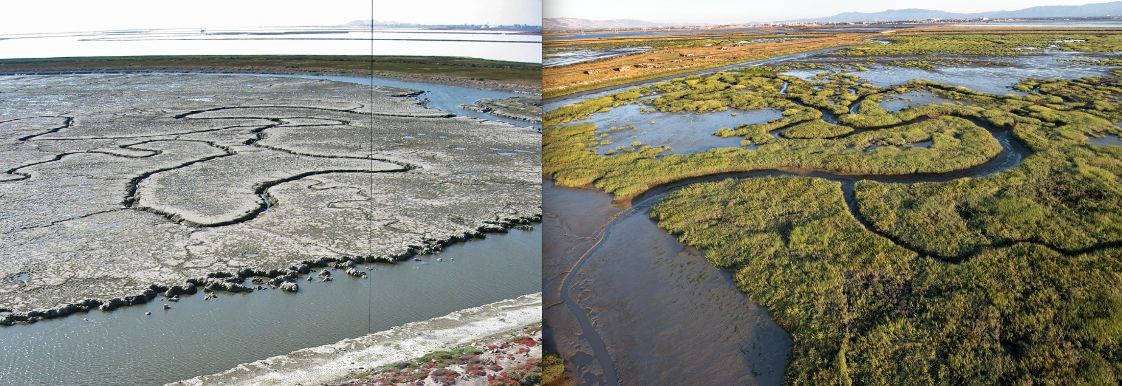You are here
When traffic slows and horns honk on the many highways of the San Francisco Bay area, the confines of the city can feel extremely close at hand. Through the work of Save The Bay and thousands of hard-working volunteers, however, Bay Area residents have opportunities to step away from the bustle and noise and find isolation and quiet in the hundreds of miles of publicly accessible shoreline trails, kayak launch points, and bay wildlife viewing areas created in concert with restoration projects dating back to 1961.
Save The Bay is a nonprofit that seeks to increase access to the bay's shoreline while actively advocating for conservation and rehabilitation of surviving tidal marshlands and defunct salt ponds. In an unprecedented vote in June, a $12 parcel tax to fund San Francisco Bay restoration was passed by 70% of Bay Area voters. Known as Measure AA, the tax was championed by Save The Bay and enjoyed widespread bipartisan support from a broad array of stakeholders. Measure AA will generate $500 million for restoration of San Francisco Bay wetlands. The bay has only 44,000 acres of tidal wetlands currently, and a lack of funding has slowed progress on restoring more. The local funding will also help the region leverage additional state and federal funding necessary to restore an anticipated 100,000 acres.
The San Francisco Bay Restoration Authority (SBRA) will collect the money beginning in tax year 2017, and that money will reach projects in 2018. Save The Bay is looking forward to working with the SBRA to ensure that the funds are properly allocated and key restoration projects receive support. As projects slowly begin to receive this new financial boost, there will be additional opportunities for supporters of the measure to volunteer on the ground at restoration sites across the bay.
The San Francisco Bay did not always offer such an abundance of shoreline and wildlife habitat. In 1961, three East Bay women, Kay Kerr, Sylvia McLaughlin, and Esther Gulick, became concerned with the rampant filling of shallow areas and plans to fill 60 percent of the remaining waterway. The future of the bay looked bleak with projections of only a narrow channel for navigation left by 2020. At that time, the public had access to fewer than 6 miles of shoreline, and the bay was choked with raw sewage and industrial pollution. Through petitions, protests, and hard work, more than 30 city garbage dumps were closed along the shoreline, and the practice of dumping raw sewage into the bay was brought to a halt. That movement grew into Save The Bay, which now has more than 50,000 members and supporters.
Save The Bay plays an important part in restoring transition zone habitat as part of their partnership with the South Bay Salt Pond Restoration Project. This work is being done in partnership with the largest wetland restoration project in the history of the bay. South Bay Salt Pond Restoration Project and the Coastal Conservancy are responsible for working to restore over 15,000 acres of industrial salt ponds back into tidal wetlands and usable habitat. These lands were acquired from Cargill, Inc. in 2003 and are part of a larger campaign to restore 40,000 acres of lost tidal wetlands to San Francisco Bay. The public can see the results of these efforts by utilizing the nearly 4 miles of newly opened shoreline trails and new wildlife viewing platforms at Eden Landing Ecological Reserve in Hayward. Thanks to these advocates and volunteers, San Francisco Bay is cleaner and healthier than it has been in half a century.
In a far cry from those pitiful 6 miles, today more than half of the bay is ringed with shoreline parks and outdoor spaces linked through nearly 300 miles of Bay trail that is open to the public for walking, biking, and viewing wildlife. Large bay-fill projects have mostly been stopped, and several large-scale wetland restoration projects are underway.
As Save The Bay continues the challenging work of protecting the bay, they are planning for the future with an eye to the effects of climate change, increased development, and increased population. The region is expected to see a 30% increase in population by 2040, placing more strain on an area already brimming with people. A focus on upstream and upland influences means developing strategies for stormwater runoff, pollution runoff, and development regulations. Through the concept of Bay Smart Communities, Save The Bay is working to encourage city spaces that catch more rain, provide more shade, and emphasize green urban infrastructure.
The inaugural Bay Day on October 1 of this year is one example of community outreach to partners bay-wide. Save The Bay hopes this regional celebration of the bay will encourage everyone from cultural organizations and small businesses to city parks and neighborhood associations to celebrate the waterways and shorelines, bringing new attention to the recreation and volunteer opportunities available. Encouraging diverse community participation is a priority at Save The Bay.
Save The Bay’s humble beginnings as three concerned women have grown into a transformative nonprofit that has brought restoration and recreation to the residents in the Bay Area. Join Save The Bay to celebrate Bay Day on October 1, volunteer at any of their numerous restoration projects, or just go for a stroll along the peaceful trails adjacent to the bay. No matter which you choose, you’ll be helping support decades of conservation in the San Francisco Bay.
To find Bay Day celebrations happening near you October 1, visit www.BayDay.org. To volunteer on a Bay restoration project, visit http://www.savesfbay.org/volunteer. Follow Save The Bay on Facebook, Twitter or Instagram, or subscribe to their newsletter.





Comments
Sign In and share them.